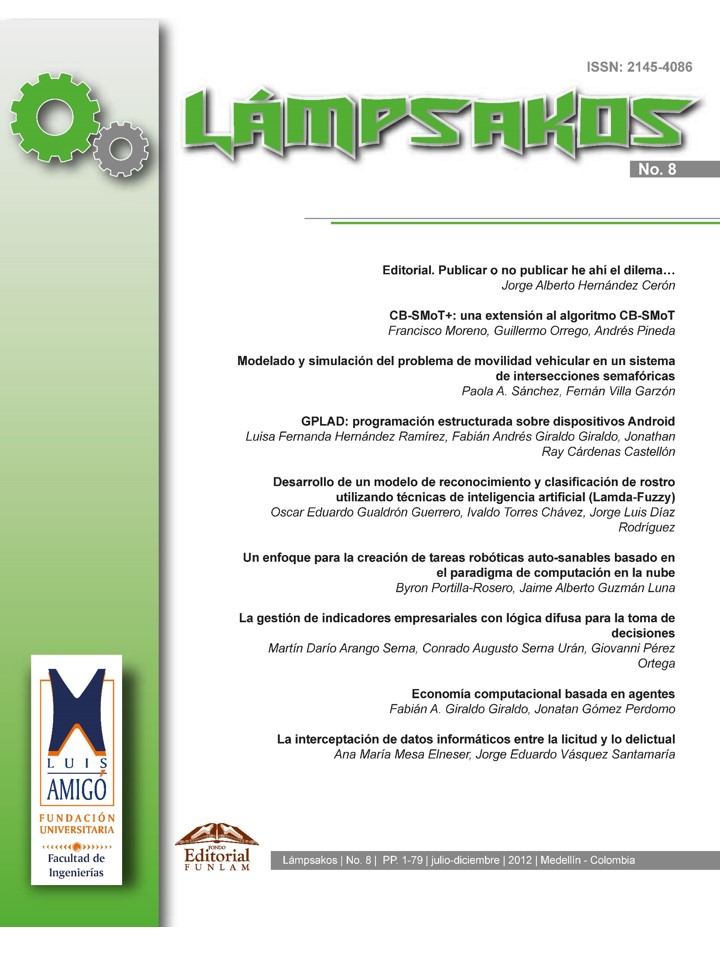CB-SMoT+: Una Extensión al Algoritmo CB-SMoT
DOI:
https://doi.org/10.21501/21454086.673Keywords:
Algoritmo CB-SMoT, Movimiento, Objetos móviles, Trayectoria, Velocidad,Abstract
Una trayectoria es un registro de la evolución de la posición de un objeto móvil. Por ejemplo, un vehículo que se mueve en el espacio durante un intervalo de tiempo. Una trayectoria se representa mediante una secuencia de observaciones que indican la posición y el tiempo en el que fue tomada cada observación. CB-SMoT es un algoritmo que identifica las partes de una trayectoria durante las cuales el objeto mantuvo una velocidad promedio por debajo de un límite dado. En este artículo se propone una extensión para dicho algoritmo que permite identificar las partes de una trayectoria durante las cuales el objeto mantuvo una velocidad promedio entre observaciones por debajo de un límite dado. Esto posibilita la identificación, por ejemplo, de violaciones a un límite de velocidad que no son advertidas por el algoritmo original. Para el estudio se usó el sistema de gestión de bases de datos PostgreSQL y los algoritmos se implementaron en su lenguaje de programación, llamado PL/pgSQL. Además, se hicieron experimentos con 100 trayectorias de vehículos con el propósito de mostrar la utilidad y la viabilidad de la propuestaDownloads
References
P. A. Longley, M Goodchild, D. J. Maguire & D. W.Rhind. “Geographic Information Systems and Science”. 560, p. 2010.
S. Spaccapietra, C. Parent, M. Damiani, J. Macedo, F. Porto & C. Vangenot. “A conceptual view on trajectories”. Data & Knowledge Engineering, Vol. 65, No. 1, pp. 126-146, Abr. 2008.
L. O. Alvares, V Bogorny, B Kuijpers, J. Macedo, B. Moelans & A. Vaisman. “A model for enriching trajectories with semantic geographical information”. In Proc. 2007 15th Annual ACM International Symposium on Advances in Geographic Information Systems, Nueva York, pp. 1-22.
A. Palma, V. Bogorny, B. Kuijpers & L. Alvares. “A Clustering-based Approach for Discovering interesting Places in Trajectories”. In Proc. 2008 ACM symposium on Applied computing, Nueva York, USA, pp. 863-868.
B. G. Heydecker & J. D Addison. “Analysis and modelling of traffic flow under variable speed limits”. Transportation Research Part C: Emerging Technologies, Vol. 19, No. 2, pp. 206-217, Abr. 2011.
M. Abdel-Aty, J. Dilmore & A. Dhindsa. “Evaluation of variable speed limits for real- time freeway safety improvement”. Accident Analysis & Prevention, Vol. 38, No. 22, pp. 335-345, Mar. 2006.
A. A. M. Aljanahi, A. H. Rhodes. A. V. Metcalfe. “Speed limits and road traffic accidents under free flow conditions”. Accident Analysis & Prevention, Vol. 31, No. 1, pp. 161-168, Ene. 1999.
R. H. Güting & M. Schneider. “Moving objects databases”. Morgan Kaufmann:San Francisco. 2005.
M. Ester, H. –P. Kriegel, J. Sander & X. Xu. “A density-based algorithm for discovering clusters in large spatial databases with noise”. In Proc. 1996 Second Conference on Knowledge Discovery and Data
Downloads
Published
How to Cite
Issue
Section
License
In accordance with national and international copyrights, as well as publishing policies of "Fundación Universitaria Luis Amigó" and its Journal "Lámpsakos" (indexed with ISSN : 2145-4086), I (we ) hereby manifest:1. The desire to participate as writers and submit to the rules established by the magazine publishers.
2. The commitment not to withdraw the manuscript until the journal finishes the editing process of the ongoing issue.
3. That article is original and unpublished and has not been nominated or submitted together in another magazine; therefore, the rights of the article in evaluation have not been assigned in advance and they do not weigh any lien or limitation for use.
4. The absence of conflict of interest with commercial institution or association of any kind
5. The incorporation of the quotes and references from other authors, tending to avoid plagiarism. Accordingly, the author affirms that the paper being published do not violate copyright, intellectual property or privacy rights of third parties. Morover, if necessary there is a way of demonstrating the respective permits original copyright to the aspects or elements taken from other documents such as texts of more than 500 words, tables, graphs, among others. In the event of any claim or action by a third party regarding copyright on the article, the author (s) will assume full responsibility and come out in defense of the rights herein assigned. Therefore, for all purposes, the Journal "Lámpsakos" of the "Fundación Universitaria Luis Amigó" acts as a third party in good faith.
6. In the event of the publication of the article, the authors free of charge and on an exclusive basis the integrity of the economic rights and the right to print, reprint and reproduction in any form and medium, without any limitation as to territory is concerned, in favor of the Journal "Lámpsakos" of the "Fundación Universitaria Luis Amigó".








